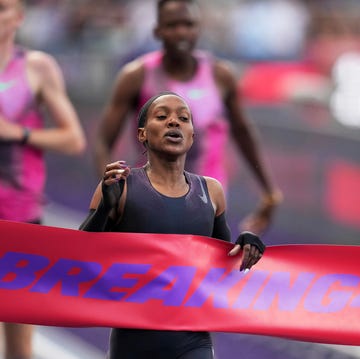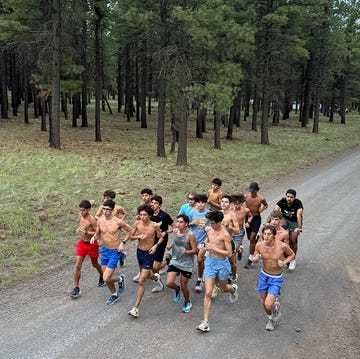As Faith Kipyegon came down the homestretch of the track at Stade Sébastien Charléty during Thursday’s Nike-sponsored “Breaking4” event, it became clear that the 31-year-old Kenyan was not going to eclipse the 4-minute mile barrier.
Kipyegon’s form started to break down and the seconds on the on-screen graphics ticked away. 4:00.00 came and went.
Instead, Kipyegon crossed the finish line and the graphics read 4:06.91 as her final time. Kipyegon would not, on this day, become the first woman ever to run a sub-4 mile, but she did run faster than her own world record of 4:07.64, which she set in 2023. This new time, however, would not count as an official world record because standard competition rules were not followed.
“Absolutely amazing. Absolutely amazing. 4:06:91,” one of the announcers, Diljeet Taylor, said on the broadcast.
A minute later, after the likes of Eliud Kipchoge and Joan Benoit Samuelson crowded around Kipyegon at the finish line, another broadcaster, Paul Swangard, shared an update. “4:06.42 is the official time for Faith Kipyegon at the mile.”
Wait, what?
Why was there over a four-tenths of a second time difference between the initial time of 4:06.91 on the screen and the “official” time of 4:06.42? Sure, sometimes the times on the screen are not always 100 percent final. And we frequently see time adjustments in track races, particularly in the sprint events. But those adjustments are usually a single hundredth of a second. But four-tenths? That’s nearly unheard of, especially at an event of this magnitude.
It turns out, the 4:06.91 was the time between the starting gun sounding and Kipyegon crossing the finish line. This is typically how track meets are timed. But Breaking4 was not an official race. Nike also tracked the time between Kipyegon crossing the start and finish line, essentially eliminating her reaction time, which resulted in the 4:06.42 mark. This was measured by a high-resolution camera system. Omega Timing was used; the company that times many high-profile track meets, such as the Olympics and Diamond League.
Nike provided a statement to Runner’s World on Saturday morning about the discrepancy.
“Breaking4 was always about redefining the limits of human potential and it resulted in a breakthrough moment in athletic performance. For us the achievement was proving what’s possible when athletes, science, and innovation come together.
“We captured precise timing for her 1-mile run—from Faith’s very first movement to the finish line, every frame was tracked using high-resolution photo-finish camera technology to ensure accuracy.
“Every element of Breaking4 was guided by rigorous scientific analysis and independently validated by third-party experts. The data captured will not only advance our understanding of elite sport today, but also fuel research to support the athletes of tomorrow.”
It was long-known that Thursday’s Breaking4 event would not be like a normal track race. Similar to Kipchoge’s sub-2-hour marathon attempts in 2017 and 2019, Kipyegon’s time would not count towards the official record books. That’s because Kipyegon used spikes that were not approved for use in competition by World Athletics, and because she used male pacesetters.
What was not known ahead of the attempt, or discussed on Thursday’s livestream at any point, was that clock would begin when she crossed the starting line, not the gun, which created a bit of confusion from those watching after the time was adjusted by nearly half a second.
Dan Beck is the deputy news editor at Runner’s World. He has led news coverage teams for major running events like the Olympic Games, World Athletics Championships, Boston Marathon, and New York City Marathon. A former collegiate distance runner at DeSales University, he still enjoys running, just more slowly now. Before coming to Runner’s World, he covered track and field and cross-country at MileSplit. He lives in Philadelphia with his wife, where the two like to explore the city’s rich dining scene.
Theo Kahler is the news editor at Runner’s World. He’s a former all-conference collegiate runner at Winthrop University, and he received his master’s degree in liberal arts studies from Wake Forest University, where he was a member of one of the top distance-running teams in the NCAA. Kahler has reported on the ground at major events such as the Paris Olympics, U.S. Olympic Trials, New York City Marathon, and Boston Marathon. He’s run 14:20 in the 5K, 1:05:36 in the half marathon, and enjoys spotting tracks from the sky on airplanes. (Look for colorful ovals around football fields.)





















